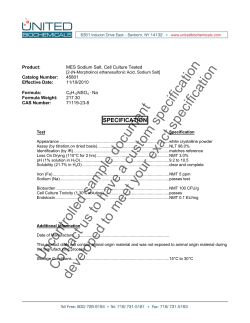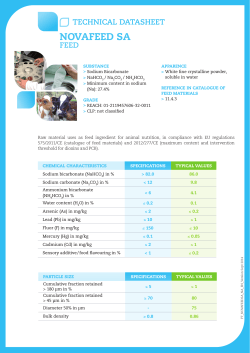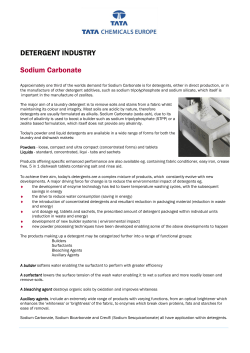
Sodium Starch Glycolate
Accessed from 10.6.1.1 by correct6 on Wed May 27 10:29:43 EDT 2015 NF 33 Official Monographs / Sodium 6875 Titrimetric system (See Titrimetry 〈541〉.) Mode: Direct titration Titrant: 0.1 N perchloric acid VS Blank: 50 mL of glacial acetic acid Endpoint detection: Visual Analysis: Dissolve the Sample in 50 mL of glacial acetic acid, and add 1 drop of crystal violet TS. Titrate with 0.1 N perchloric acid VS to a green endpoint. Perform a blank determination, and make any necessary correction. Calculate the percentage of sodium propionate (C3H5NaO2) in the Sample taken: Result = [(VS − VB) × N × F × 100]/W VS = volume of the Titrant consumed by the Sample (mL) VB = volume of the Titrant consumed by the Blank (mL) N = actual normality of the Titrant (mEq/mL) F = equivalency factor, 96.06 mg/mEq W = weight of the Sample (mg) Acceptance criteria: 99.0%–100.5% on the dried basis IMPURITIES Delete the following: •• HEAVY METALS, Method I 〈231〉 . Test preparation: Dissolve 2 g of Sodium Propionate in 1 mL of 1 N acetic acid and sufficient water to make 25 mL. Acceptance criteria: NMT 10 ppm• (Official 1-Dec-2015) SPECIFIC TESTS • WATER DETERMINATION, Method I 〈921〉: NMT 1.0% • ALKALINITY Sample solution: 2.0 g of Sodium Propionate in 20 mL of water Analysis: Add phenolphthalein TS to the Sample solution. Acceptance criteria: If a pink color is produced, it is discharged by 0.60 mL of 0.10 N sulfuric acid. ADDITIONAL REQUIREMENTS • PACKAGING AND STORAGE: Preserve in tight containers. • USP REFERENCE STANDARDS 〈11〉 USP Sodium Propionate RS Sodium Starch Glycolate Portions of this monograph that are national USP text, and are not part of the harmonized text, are marked with symbols (◆◆) to specify this fact. Starch carboxymethyl ether, sodium salt. . DEFINITION Sodium Starch Glycolate is the sodium salt of a carboxymethyl ether of starch or of a cross-linked carboxymethyl ether of starch. It may contain NMT 7.0% of Sodium Chloride. The pH and assay requirements for Type A and Type B are set forth in the accompanying table. pH Type A B Min. 5.5 3.0 Max. 7.5 5.0 % Sodium, Combined as Sodium Starch Glycolate Min. Max. 2.8 4.2 2.0 3.4 . . ASSAY • PROCEDURE Sample: 1 g Analysis: Transfer the Sample to a conical flask, add 20 mL of 80% alcohol, stir for 10 min, and filter. Repeat the extraction until the chloride has been completely extracted, as shown by a test with silver nitrate. Dry the insoluble portion at 105° to constant weight, and transfer an accurately weighed portion (700 mg) of the dried 80% alcohol–insoluble portion to a suitable flask. Add 80 mL of glacial acetic acid, and heat the mixture under reflux on a boiling water bath for 2 h. Cool to room temperature, and titrate with 0.1 N perchloric acid VS, determining the endpoint potentiometrically. Calculate the percentage of sodium combined in the form of sodium starch glycolate: Result = 100 × (22.99) × V × N/W V N W = volume of perchloric acid consumed (mL) = normality of the perchloric acid = weight of the dried alcohol–insoluble residue taken for the Assay (mg) Acceptance criteria: 2.8%–4.2% for Type A; 2.0%–3.4% for Type B OTHER COMPONENTS • LIMIT OF SODIUM CHLORIDE Sample: 500 mg of Sodium Starch Glycolate Titrimetric system (See Titrimetry 〈541〉.) Mode: Direct titration Titrant: 0.1 N silver nitrate VS Endpoint detection: Potentiometric Electrodes Indicator: Suitable silver-based Reference: Double junction electrode containing a 10% potassium nitrate filling solution in the outer jacket, and a standard filling solution in the inner jacket Analysis: Transfer the Sample to a beaker, and suspend in 100 mL of water. Add 1 mL of nitric acid. Titrate with the Titrant. Each mL of 0.1 N silver nitrate is equivalent to 5.844 mg of sodium chloride. Acceptance criteria: NMT 7.0% • LIMIT OF SODIUM GLYCOLATE [NOTE—Conduct this test without exposure to daylight. Use low-actinic glassware.] Solution A: 0.1 mg/mL of 2,7-dihydroxynaphthalene in sulfuric acid; allow to stand until decolorized, and use within 2 days. Standard solution: Transfer 310 mg of glycolic acid, previously dried over phosphorus pentoxide in a desiccator at room temperature overnight, to a 500-mL vol- Official from May 1, 2015 Copyright (c) 2015 The United States Pharmacopeial Convention. All rights reserved. NF Monographs . IDENTIFICATION • ◆A. INFRARED ABSORPTION 〈197K〉◆ • B. An acidified solution of it is colored blue to violet by the addition of iodine and potassium iodide TS 1. • C. PROCEDURE Potassium pyroantimonate solution: Dissolve 2 g of potassium pyroantimonate in 85 mL of hot water. Cool quickly, and add 10 mL of a solution of potassium hydroxide (3 in 20). Allow to stand for 24 h, filter, and dilute with water to 100 mL. Analysis: To a 2-mL portion of the Sample solution prepared for the test for Limit of Iron, add 2 mL of 15% potassium carbonate, and heat to boiling. No precipitate is formed. Add 4 mL of Potassium pyroantimonate solution, and heat to boiling. Allow to cool in ice water and, if necessary, rub the inside of the test tube with a glass rod. Acceptance criteria: A dense precipitate is formed. • ◆D. Sodium Starch Glycolate imparts an intense yellow color to a nonluminous flame.◆ Accessed from 10.6.1.1 by correct6 on Wed May 27 10:29:43 EDT 2015 6876 Sodium / Official Monographs umetric flask. Dissolve in and dilute with water to volume. Transfer 5.0 mL of this solution to a 100-mL beaker, add 4 mL of 6 N acetic acid, and allow to stand for about 30 min. Add 50 mL of acetone and 1 g of sodium chloride, mix, and pass through fast filter paper moistened with acetone into a 100-mL volumetric flask. Rinse the beaker and the filter paper with acetone. Combine the filtrate and washings, dilute with acetone to volume, and mix. Allow to stand for 24 h without shaking. Use the clear supernatant as the Standard solution. Sample solution: Transfer 200 mg to a 100-mL beaker. Add 4 mL of 6 N acetic acid and 5 mL of water. Stir until dissolution is complete (about 10 min). Add 50 mL of acetone and 1 g of sodium chloride, mix, and pass through fast filter paper moistened with acetone into a 100-mL volumetric flask. Rinse the beaker and filter paper with acetone. Combine the filtrate and washings, dilute with acetone to volume, and mix. Allow to stand for 24 h without shaking. Use the clear supernatant as the Sample solution. Analysis: Treat the Sample solution and the Standard solution as follows. Heat 2.0 mL of the solution on a water bath for 20 min to remove the acetone. Cool to room temperature. Add 20.0 mL of Solution A to the solution under test, mix, and heat on a water bath for 20 min. Cool under running water, and quantitatively transfer to a 25-mL volumetric flask. Maintain the flask under running water, and dilute with sulfuric acid to volume. Within 10 min, determine the absorbance of the solution at 540 nm with a suitable spectrophotometer, using water as the blank. Acceptance criteria: The absorbance of the Sample solution is NMT that of the Standard solution (2.0%). IMPURITIES Delete the following: •• ◆HEAVY METALS, Method II 〈231〉: 20 ppm◆• (Official 1-Dec. . NF Monographs 2015) • LIMIT OF IRON Standard solution: Dissolve 863.4 mg of ferric ammonium sulfate [FeNH4(SO4)2 · 12H2O] in water, add 25 mL of 2 N sulfuric acid, dilute with water to 500.0 mL, and mix. Pipet 10 mL of this solution into a 100-mL volumetric flask, dilute with water to volume, and mix. Pipet 5 mL of this solution into a 100-mL volumetric flask, dilute with water to volume, and mix. This solution contains the equivalent of 1.0 µg/mL of iron. Sample solution: Place 2.5 g in a silica or platinum crucible, and add 2 mL of 10 N sulfuric acid. Heat on a water bath, then cautiously raise the temperature progressively over an open flame. Ignite, preferably in a muffle furnace, at 600 ± 25°. Continue heating until all black particles have disappeared. Cool, add a few drops of 2 N sulfuric acid, and heat and ignite as above. Add a few drops of 2 M ammonium carbonate, evaporate to dryness, and ignite as above. Cool, dissolve the residue in 50 mL of water, and mix. [NOTE—Reserve a portion of this solution for Identification test C.] Analysis: Treat the Sample solution and the Standard solution as follows. Transfer 10 mL of the solution to a suitable beaker, add 2 mL of citric acid solution (1 in 5) and 0.1 mL of thioglycolic acid, and mix. Render the solution alkaline, using litmus paper as an external indicator, by the addition of ammonium hydroxide. Dilute with water to 20 mL, and mix. Allow the solutions to stand for 5 min. Acceptance criteria: The color of the solution from the Sample solution is a shade of pink no deeper than that of the solution from the Standard solution (0.002%). NF 33 SPECIFIC TESTS • MICROBIAL ENUMERATION TESTS 〈61〉 and TESTS FOR SPECIFIED MICROORGANISMS 〈62〉: It meets the requirements of the tests for absence of Salmonella species and Escherichia coli. • PH 〈791〉: Disperse 1 g in 30 mL of water. The pH of the resulting suspension is either 5.5–7.5 for Type A or 3.0–5.0 for Type B. • LOSS ON DRYING 〈731〉 Analysis: Dry at 130° for 90 min. Acceptance criteria: NMT 10.0% ADDITIONAL REQUIREMENTS • ◆PACKAGING AND STORAGE: Preserve in well-closed containers, preferably protected from wide variations in temperature and humidity, which may cause caking.◆ ◆ • LABELING: Label it to indicate the botanical source of the starch from which it was derived, the cross-linking agent (if used), the pH range, and whether it is Type A or Type B.◆ • USP REFERENCE STANDARDS 〈11〉 USP Sodium Starch Glycolate Type A RS USP Sodium Starch Glycolate Type B RS . . . Sodium Stearate Octadecanoic acid, sodium salt; Sodium stearate [822-16-2]. DEFINITION Sodium Stearate is a compound of sodium with a mixture of solid organic acids obtained from sources of vegetable or animal origin and consists mainly of variable proportions of sodium stearate (C18H35NaO2) and sodium palmitate (C16H31NaO2). The content of stearic acid in the fatty acid fraction is NLT 40.0% of the total content. The sum of stearic acid and palmitic acid in the fatty acid fraction is NLT 90.0% of the total content. Sodium stearate contains small amounts of the sodium salts of other fatty acids. IDENTIFICATION • A. Analysis: Heat a small quantity of Sodium Stearate in a crucible over a flame until it fuses. Continue heating the sample until it decomposes with emission of flammable vapors that should burn when ignited. Moisten the residue with water, and test with red litmus paper. The paper must turn blue. Add a small amount of acid to the crucible, and observe the solution effervesce. The solution must impart an intense yellow color to a nonluminous flame. Acceptance criteria: Meets the requirements • B. The retention times of the major peaks of the Sample solution correspond to those of the Standard solution, as obtained in the Assay. ASSAY • PROCEDURE Boron trifluoride–methanol solution: 140 g/L of boron trifluoride in methanol Sample solution: Dissolve 100 mg of Sodium Stearate in a small conical flask, fitted with a suitable reflux attachment, with 5 mL of Boron trifluoride–methanol solution. Boil under reflux for 10 min. Add 4.0 mL of nheptane through the condenser, and boil again under reflux for 10 min. Allow to cool. Add 20 mL of a saturated solution of sodium chloride. Shake, and allow the layers to separate. Remove about 2 mL of the organic layer, and dry it over 0.2 g of anhydrous sodium sulfate. Dilute 1.0 mL of this solution with n-heptane to 10.0 mL. Official from May 1, 2015 Copyright (c) 2015 The United States Pharmacopeial Convention. All rights reserved.
© Copyright 2025









